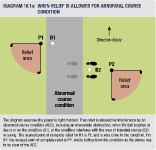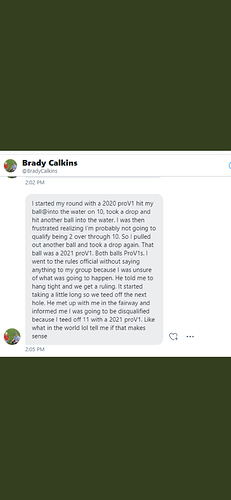Hmmm, the world seems to be abuzz about the 18th hole and the final group today…still my opinion, but I would have rather seen Mr Westwood have the opportunity to stiff one than have to hit and hope. AND even though I love Bryson and his approach to the game…he hit a rather crappy approach shot 2 holes prior, gave some lame excuse about his intended line while in the rough because the sprinkler head was in his way…every announcer called BS, gets the free drop and saves par because he made his shot 10 times easier. Yes, he used the rules to his full advantage there and technically you couldn’t complain, but at that point the tournament had devolved to match play…so yea…Hit into a divot after piping one 340…I know how I feel about it https://twitter.com/TwoInchesShort/status/1368701163290292227?ref_src=twsrc^tfw|twcamp^tweetembed|twterm^1368701163290292227|twgr^|twcon^s1_c10&ref_url=https%3A%2F%2Fthespun.com%2Fmore%2Fgolf%2Fgolf-world-reacts-paige-spiranac-rules-suggestion
Seeing these guys chip in the pond on 15 from the behind the green. I know they can play a shot from the same spot but this question is for back of line relief
Does the reference line start from the hole and run backwards through the reference point or does it extend both directions
I read 17.1d but still not clear… it does say “straight back from the hole”
(2) Back-On-the-Line Relief. The player may drop the original ball or another ball (see Rule 14.3) in a relief area that is based on a reference line going straight back from the hole through the estimated point where the original ball last crossed the edge of the penalty area
The way I read this, “from the hole through the estimated point…”, the reference line goes one direction only. The point where the ball last crossed the edge of the penalty is then between the hole and the Relief Area. This is the same concept used in the previous version of the Rules:
Drop a ball behind the water hazard, keeping the point at which the original ball last crossed the margin of the water hazard directly between the hole and the spot on which the ball is dropped, with no limit to how far behind the water hazard the ball may be dropped;
revised slightly for the new concept of Relief Area.
Edit to add this, going back to a basic geometry term. The “reference line” is in actuality a “ray”, that is a portion of a line that has a fixed end point (the hole), and extends infinitely on one direction only.
The situations we saw on 15 yesterday (or when a ball completely crosses water but rolls back in) have always confused me, Dave.
Clearly you can replay from the previous spot (Lowry), but where could he have dropped if he’d chosen to? Would he have had to go back across the water to keep the point of entry between him and the hole? Is it the same if an approach lands on the green and spins back into the water? Thanks!
That’s right, if he chooses “back on the line” relief, he would have to be on the other side of the water. If you look at the Rules, under Committee Procedures, Section 2c(4) talks about why a Committee would choose to mark an area as a Yellow Penalty Area. Marking the area as Yellow ensures that the player MUST hit the ball over the water, no matter where it enters the Penalty Area, if he takes the “back on the line” option…
This is the rigor and precision I have come to expect!!
This one is pretty straightforward to me. Reading the part from Committee Procedures helps bring clarity, in my mind, helps explain the reason for requiring the drop “behind” the penalty area. As I’ve learned more about the Rules, I’ve tried to find areas of commonality among varying rules, and reasons why THIS situation should be treated similarly to THAT situation, but differently from THIS OTHER situation. Its a lot easier to remember that way, instead of treating the Rules as 1000 different treatments for each of 1000 different situations.
I glanced at the rule book, but I’m not sure on this one…
My ball is on the right side of the cart path, I’m right handed… how do I determine the nearest point of relief? To drop it on the right side requires I move it to the point where I’m not standing on the cart path either. Left side is a foot off the cart path…
If both directions are about equal in distance, do I get to decide?
It could be either depending on which provides the closest point of complete relief. If in doubt, take a stance with complete relief to the right and mark where the ball would be with a tee. Then do the same thing with the left. Compare which is closer to where your ball finished. That’s where you should drop.
Minor addition, thats your Reference Point, drop within 1 club length, no closer to the hole, and be sure that the final ball position offers complete relief for your stance and swing.
And if that nearest point is in a bush or behind a tree, its still your reference point if you choose to take relief. Its a good idea to check, before you lift your ball.
This is from 16.1a

Check Interpretation 16.1/1 to read about how the position may be better or worse after taking relief.
Yeah, I read the rule and understand the closest point of relief, but there is a point on the cart path where it’s equal distance either way… if it’s on the right middle of the cart path, relief is either 4 feet right or 4 feet left, for instance…
Is it possible for a ball to be in the middle of a cart path and equidistance from the hole on one side or the other? Cart path would almost have to be in the center of the fairway for this to be the case.
You’re required to take complete relief for stance and swing, which means that going to the right side (considering a right-handed golfer) your feet must be off the path. To the left, only the ball has to be off the path. If the ball is dead center of the path, the Nearest Point of Complete Relief (NPCR) will be to the left side. There’s definitely a spot on the path, somewhere near the right side, where there are two candidates for NPCR that are the same distance from the original ball, one on each side of the path. In that case, I’d trust the player’s judgement (see Rule 1.3b(2))
The concern is that the NPCR is as close as possible to the ball’s original position, and not closer to the hole. For a path that’s not down the center of the fairway, say its down the right side, you might move a little forward if your NPCR is to the right, or a little back if the NPCR is to the left side. You still MUST use the point of complete relief that is closest to the ball’s original position.
This may be the most violated rule in casual golf…
I see a big preference for taking the “most convenient” relief amongst my peers
They would have to be exactly equal for you to decide…
If it is close and you aren’t sure you mark with tees and measure
I actually thought about this, and the easiest way to measure this would be to address the ball on the cart path… if the back of your heel is closer to relief than the ball, you’d go left and if the ball is closer to relief, then you’d go right…
Full disclosure, I took the drop that was in my advantage and made bogey after forgetting to play smart and leaving it short trying to hit the ball to the pin…
Glad I don’t play “Serious” golf. I have a pro shop selection of balls in my bag.
The one ball rule only applies to professional golf, as far as I know… I agree it doesn’t make sense but might be to stave off guys having 6 different balls for a variety of shots…

